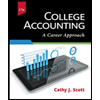
The accounting entries which are made at the end of an accounting period to change the closing balances of various general ledger accounts. They are made to align the reported results and financial position of the business in accordance with the accounting framework, such as GAAP or IFRS.
Rules of
To increase the balance of account one needs to debit assets, expenses, losses and credit all the liabilities, revenues and gains including capital. To decrease the balance of account credit all assets, expenses, losses and debit all liabilities, revenues and gains including capital.
Perpetual Inventory System:
The inventory system in which the inventory accounts are updated on each purchase or sale in inventory. Quantities of inventory are updated on continuous basis. This can be done by integrating the inventory system to order entry and to the retail sale point of system.
Gross margin ratio:
It means the ratio of gross profit earned to net sales. Formula to compute it:
Gross Margin Ratio=Gross ProfitNet Sales
It is ratio which gives idea about the ability of company to pay it liabilities. Formula to compute it:
Current ratio=Current AssetsCurrent liabilities
Acid Test ratio:
It measures the ability of company to use cash or its liquid assets or paying off current liabilities. Formula to compute it:
Acid test Ratio=Current assets - (Stock+Prepaid expenses)Current Liabilities
1.
To prepare: Adjusting entries.
Explanation of Solution
(a)
Physical count of Store supplies at the year end shows $3,700 still available but Store supplies listed shows $9,700.
| Date | Account Title and Explanation | Post ref | Debit($) | Credit($) |
| Jan 31 | Supplies expense | 6,000 | ||
| Store supplies | 6,000 | |||
| (To record supplies consumed during the period) |
Table (1)
- Supplies expense account is an expense account. Since Supplies expense is increased, expense is to be increased. So, debit the Supplies expense account.
- Store supplies account is an asset account. Since inventory is shrinked, so it is to be reduced. Therefore, Store supplies account is to be credited.
Working note:
Computation of Inventory shrinkage,
Supplies Expense=Supply listed−Supply still available=$9,700−$3,700=$6,000
(b)
Prepaid selling expenses worth $1,400 have expired:
| Date | Account Title and Explanation | Post ref | Debit($) | Credit($) |
| Jan 31 | Insurance expense | 2,800 | ||
| Prepaid insurance expense | 2,800 | |||
| (To record expired prepaid selling expense) |
Table (2)
- Insurance expense is an expense account. Since Insurance expense is increased, expense is to be increased. So, debit the Insurance expense account.
- Prepaid insurance expense is an asset account. Since Prepaid insurance expense have expired resulting a decrease in asset, so asset is to be decreased. Therefore Prepaid insurance expense account is credited.
(c)
| Date | Account Title and Explanation | Post ref | Debit($) | Credit($) |
| Jan 31 | Depreciation expense | 3,000 | ||
| Store equipment | 3,000 | |||
| (To record depreciation on office equipment) |
Table (3)
- Depreciation expense is an expense account. Since Depreciation expense is to be recorded, expense is to be increased. So, debit the Depreciation expense account.
- Store equipment is an asset account. Since,Depreciation expense is to be recorded resulting a decrease in asset, so asset is to be decreased. Therefore Store equipment account is credited.
(d)
Physical count of merchandise inventory at the year end shows $21,300 still available but merchandise inventory listed shows $24,000.
| Date | Account Title and Explanation | Post ref | Debit($) | Credit($) |
| Jan 31 | Cost of goods sold | 2,700 | ||
| Merchandise inventory | 2,700 | |||
| (To record inventory shrinkage cost) |
Table (4)
- Cost of goods sold account is an expense account. Since goods are shrinked, expense is to increased. Therefore, Cost of goods sold account is debited.
- Merchandise inventory account is an asset account. Since inventory is shrinked, so it is to be reduced. Therefore, merchandise inventory account is to be credited.
Working note:
Computation of Inventory shrinkage,
Inventory shrinkage=Inventory listed−Inventory still available=$24,000−$21,300=$2,700
2.
To prepare: Multi step Income Statement.
2.
Explanation of Solution
| Company F | ||
| Multi step Income Statement | ||
| For the Year Ended December 31,2017 | ||
| Particulars | Amount($) | Amount($) |
| Sales Revenue | 227,100 | |
| Less: Sales Returns and Allowances | (5,000) | |
| Sales discount | (1,000) | (6,000) |
| Net Sales | 221,100 | |
| Less: Cost of Goods Sold | (78,500) | |
| Gross Profit | 142,600 | |
| Less: Operating expenses | ||
| Selling expenses | ||
| Advertising expense | (17,800) | |
| General and admin Expenses | ||
| Store supply expense | (6,000) | |
| Rent expense | (26,000) | |
| Insurance expense | (2,800) | |
| Depreciation | (3,000) | |
| Salaries | (63,000) | |
| (100,800) | ||
| Total other revenues and gains | 118,600 | |
| Net income | 24,000 | |
Table (5)
Hence, Net income of Company F is $24,000
3.
To prepare: Single step Income Statement.
3.
Explanation of Solution
| Company F | ||
| Single Step Income Statement | ||
| Particulars | Amount($) | Amount($) |
| Net Sales | 221,100 | |
| Less: Expenses | ||
| Cost of goods sold | (78,500) | |
| Selling expenses | (17,800) | |
| General and admin Expenses | (100,800) | (197,100) |
| Net income | 24,000 | |
Table (6)
Hence, Net income of Company F is $24,000
4.
To Compute: Current and Acid test ratio and Gross margin ratio.
4.
Explanation of Solution
Given,
Cash is $7,400.
Merchandise inventory is $21,300.
Store supplies are $3,700.
Prepaid asset is $3,800.
Current liabilities are $18,000.
Formula to compute Current ratio: Current ratio=Current AssetsCurrent liabilities
Substitute current assets by $36,200 and current liabilities by$18,000.
Current ratio=$36,200$18,000=2.01
Working notes:
Computation of Current Assets,
Current assets=Cash+Inventory+store supplies+Prepaid insurance=7,400+21,300+3,700+3,800=$36,200
Calculated,
Current assets are $36,200.
Merchandise inventory is $21,300.
Store supplies are $3,700.
Prepaid asset is $3,800.
Current liabilities are $18,000.
Formula to compute Acid test ratio: Acid test Ratio=Current assets - (Stock+Prepaid expenses)Current Liabilities
Substitute current assets by $36,200, stock by (21,300+3,700)25,000, prepaid expenses by $3,800 and current liabilities by$18,000.
Current ratio=$36,200−(25,000+3,800)$18,000=$36,200−$28,800$18,000=$7,400$18,000=0.41
Gross profit is $142,600. (From part 2)
Net sales is $221,100. (From part 2)
Formula to compute Gross margin ratio:
Gross Margin Ratio=Gross ProfitNet Sales
Substitute Gross profit by $142,600 and Net sales by $221,100.
Gross margin ratio=$142,600$221,100=64.50%
Hence, Gross Margin ratio of Company F is 64.50%, Current ratio is 2.01, Acid test ratio is 0.41.
Want to see more full solutions like this?
Chapter 4 Solutions
FINANCIAL ACCT.FUND.(LOOSELEAF)
- I need help with this general accounting problem using proper accounting guidelines.arrow_forwardIntrasol Inc. sells a product at $52 per unit. The variable cost per unit is $30, total fixed costs are $28,000, and the company sells 7,200 units. If the tax rate is 30%,what is the net income?arrow_forwardThe liabilities of Underwood Corporation are $93,420. Also, common stock account is $167,500, dividends are $84,300, revenues are $512,680, and expenses are $395,240. What is the amount of Underwood Corporation's total assets?arrow_forward
- The Terra corporation uses the straight-line method to depreciate its machinery. On March 1, 2022, the company purchased some machinery for $360,000. The machinery is estimated to have a useful life of eight years and a salvage value of $40,000. How much depreciation expense should Terra record for the machinery in the adjusting entry on December 31, 2022?arrow_forwardI need help with this problem and accounting questionarrow_forwardStevenson Corporation reported a pretax book income of $500,000 in 2022. Included in the computation were favorable temporary differences of $60,000, unfavorable temporary differences of $25,000, and favorable permanent differences of $50,000. What is the book equivalent of taxable income for Stevenson Corporation? Ansarrow_forward
- The 2014 balance sheet of Sugarpova's Tennis Shop, Inc., showed long- term debt of $6.1 million, and the 2015 balance sheet showed long- term debt of $6.3 million. The 2015 income statement showed an interest expense of $210,000. During 2015, the company had a cash flow to creditors of $10,000 and the cash flow to stockholders for the year was $65,000. Suppose you also know that the firm's net capital spending for 2015 was $1,460,000 and that the firm reduced its net working capital investment by $87,000. What was the firm's 2015 operating cash flow, or OCF?arrow_forwardA company sells goods at a mark-up of 80% on cost. The total sales revenue is $500,000. What is the cost of sales?arrow_forwardPlease provide the solution to this financial accounting question with accurate financial calculations.arrow_forward
- Century 21 Accounting Multicolumn JournalAccountingISBN:9781337679503Author:GilbertsonPublisher:Cengage
 Intermediate Accounting: Reporting And AnalysisAccountingISBN:9781337788281Author:James M. Wahlen, Jefferson P. Jones, Donald PagachPublisher:Cengage Learning
Intermediate Accounting: Reporting And AnalysisAccountingISBN:9781337788281Author:James M. Wahlen, Jefferson P. Jones, Donald PagachPublisher:Cengage Learning - Principles of Accounting Volume 1AccountingISBN:9781947172685Author:OpenStaxPublisher:OpenStax College
 Financial AccountingAccountingISBN:9781337272124Author:Carl Warren, James M. Reeve, Jonathan DuchacPublisher:Cengage Learning
Financial AccountingAccountingISBN:9781337272124Author:Carl Warren, James M. Reeve, Jonathan DuchacPublisher:Cengage Learning College Accounting (Book Only): A Career ApproachAccountingISBN:9781337280570Author:Scott, Cathy J.Publisher:South-Western College Pub
College Accounting (Book Only): A Career ApproachAccountingISBN:9781337280570Author:Scott, Cathy J.Publisher:South-Western College Pub





